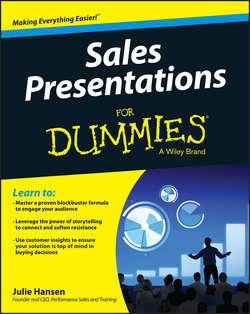Читать книгу Sales Presentations For Dummies - Julie M. Hansen - Страница 15
На сайте Литреса книга снята с продажи.
Part I
Getting Started with Sales Presentations
Chapter 3
Tailoring Your Value Proposition to Fit Your Audience
ОглавлениеIn This Chapter
▶ Comprehending why value is critical
▶ Creating a strong value proposition
▶ Tailoring your message based on the decision-maker’s role
▶ Weaving value throughout your presentation
In an age where you can customize anything over the Internet or order any one of 87,000 varieties of drinks at your local coffee shop, to deliver your presentation in only one flavor is a recipe for disaster. Today’s decision makers want to do business with salespeople who exhibit a clear understanding of their issues, not a one-size-fits-all solution. Delivering a message focused on what is important to the prospect, as opposed to what you have to sell, allows you to create value and rise above the competitive noise to become a preferred vendor.
Value serves as the organizational principle around which your presentation is constructed. It helps you determine what out of the entire pool of information you’ve collected to keep and what you can leave on the editing room floor. Although simply throwing as many features and benefits into your presentation as possible and hoping that some – or any – hit home is tempting, this type of data dump presentation is a waste of time for both you and your prospect. After a prospect feels you aren’t addressing his unique needs or challenges, you have few options to keep him engaged – 87,000 features notwithstanding.
This chapter helps you understand the often-confused differences between features, benefits, and value. You discover how to create a compelling value proposition and tailor it to address the varied needs and objectives of the decision makers and key influencers in your audience. I include several examples of value propositions and help you find out where to highlight value within your presentation to drive home your message.
Understanding Why Value Is King
Of course you didn’t set out to sell a commodity, but if your prospects don’t see a significant difference between you and your competitors other than price, you may as well be selling sugar, wheat, or pork bellies. Many salespeople put together beautiful, interesting presentations only to end up competing on price because they failed to establish value.
The competitive environment for most products has increased dramatically. Name a feature and your competitor either has it or soon will have it. Like designer handbags, a perpetual flow of look-alikes is poised to go after your customers. Even though these competitors may not offer the same quality, benefits, or service as you, you must acknowledge their existence and find a way to establish preference with your prospect. After all, if your competitor can offer the same value for less money, you won’t win the business. In order to avoid the shifting loyalty and competitive price wars that are the unfortunate companions of selling a commodity, your presentation needs to deliver a strong, clear value message that resonates with your prospect and deliver it at strategic points throughout your presentation.
The meaning of value shifts over time so it’s important to understand what makes value important in today’s economy and how to make a clear distinction between value, features, and benefits.
Grasping what makes value important
Value, the importance, worth, or usefulness of something, isn’t a new concept. However, in the past decade it has become front and center in the sales spotlight for the following reasons:
✔ Multiple choices: The days of having the only game in town are long gone for most companies and salespeople. Even new product innovations and service categories often only enjoy a brief honeymoon period before finding themselves facing renewed competition.
✔ Similar features: Although your product or service certainly has some unique qualities, often many variations of the same feature are available – or soon will be available – in the market that can also provide a solution to your prospect’s challenge or help them achieve his goals.
✔ Feature overload: Especially with complex products, the sheer number of features to compare when evaluating a solution can overwhelm even the most hearty prospect and cause decision fatigue, a proven condition which can result in irrational or unpredictable buying behavior due to the depletion of willpower. Refer to the nearby sidebar, “Examining decision fatigue.”
✔ Similar messaging: Maybe your product is completely unique, but the competition has done a good job of positioning its product in a way that makes it look or sound similar to yours, thus effectively blurring the lines of distinction in your prospect’s eyes. Ultimately, value isn’t about reality, but about your customer’s perception of reality.
The Doubletree cookie: Rising above commodity status
I was booking a stay in New York through a travel agent. She quickly identified several properties within my price range, near my destination, and within my budget. Comparing the availability of rewards programs, Wi-Fi, shuttle service, gyms, and so on, I still couldn’t define a clear winner. Finally the agent said, “Have you ever stayed at a Doubletree?” “No,” I said, “why?” “They give you these fantastic warm chocolate chip cookies when you check in. It makes you feel like you’re right at home.” Sold. A $700 business decision influenced by an item that probably cost the Doubletree less than a nickel. Doubletree found an innovative way to break out of the commodity business by communicating their value proposition – a warm reception and the promise of a consistent, quality experience – in a simple and memorable way.
Understanding the difference between features, benefits, and value
You’ve managed to communicate some value in order to secure a presentation, but be assured your competitor has – and will – be tightening its focus on value as well. You now need to step up your understanding of value in order to use it to your full advantage.
Конец ознакомительного фрагмента. Купить книгу
